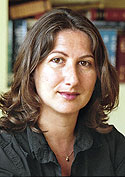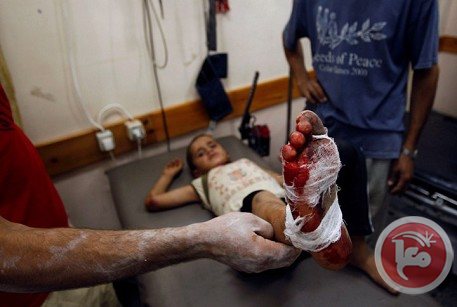Does the New York Times consider Israeli goats more important than Palestinian children?
 Today’s New York Times features a headline that reverses the sequence of events described in the story it is allegedly representing. It also omits significant information.
Today’s New York Times features a headline that reverses the sequence of events described in the story it is allegedly representing. It also omits significant information.
The headline reads: “Israel Launches Airstrikes After Attacks From Gaza” in a story bylined by Isabel Kershner. In other words, in its usual fashion, the New York Times headline tells readers that Israeli violence is defensive and came after Palestinians initiated the violence.
In reality, it was the opposite, as the lead paragraph states: “ militants from fired a barrage of rockets and mortar shells into Israeli territory on Monday, causing no casualties but some property damage, AFTER an Israeli airstrike wounded at least 10 Palestinians in southern Gaza on Sunday [emphasis added].”
Farther down, the story reports, “The latest flare-up began with the [Israeli] missile strike on Sunday against two men who Israel said were members of jihadist groups…. at least eight passers-by were also injured.”
In addition to reversing the party responsible for the initiation of violence, the Times‘ story also omits information about the 8 people who were “also injured.” Were they old men? Women? Children? What is the nature of their injuries? Will any be permanent?
The Times doesn’t tell us. Yet, while reporter Isabel Kershner didn’t bother to obtain or convey this information, she does tell us, “Several goats were killed in a petting zoo in an Israeli communal farm…”
 Other news media provide some of the missing information. According to the Middle East Media Center (IMEMC), an infant and four other children were among the injured. Three of the injured are in serious condition. IMEMC reports that the missiles were fired into a crowded area that included school students heading home from evening school.
Other news media provide some of the missing information. According to the Middle East Media Center (IMEMC), an infant and four other children were among the injured. Three of the injured are in serious condition. IMEMC reports that the missiles were fired into a crowded area that included school students heading home from evening school.
The New York Times story also doesn’t disclose the fact that the reporter, Isabel Kershner, is an Israeli citizen. (The Times refuses to answer questions about whether she has served in the Israeli military, or whether she has family members currently serving in the Israeli military or that served in it in the past.)
Kershner, is an Israeli citizen. (The Times refuses to answer questions about whether she has served in the Israeli military, or whether she has family members currently serving in the Israeli military or that served in it in the past.)
[UPDATE, Aug. 8, 2018: Two years after I wrote this blog post it came out that Kershner’s son is in the Israeli military and her husband, Hirsh Goodman, worked for an Israeli thinktank where his work was to help shape Israel’s image in news media.]
The previous New York Times bureau chief for the region, Ethan Bronner, had a son serving in the Israeli army, and many of the journalists in the area have similar personal connections to the Israeli military. The New York Times has a history of appointing bureau chiefs with ties to Israel.
A 2005 study found that the Times had reported on Israeli children’s deaths at a rate seven times greater than it reported on Palestinian children’s deaths.
While the New York Times and other US media frequently report that Palestinian violence has interrupted what the media call “a period of calm,” a 2009 study by an MIT professor revealed, “[I]t is overwhelmingly Israel that kills first after a pause in the conflict.”
The study found, “79% of all conflict pauses were interrupted when Israel killed a Palestinian, while only 8% were interrupted by Palestinian attacks (the remaining 13% were interrupted by both sides on the same day).
In addition, the researchers stated, “…of the 25 periods of nonviolence lasting longer than a week, Israel unilaterally interrupted 24, or 96%, and it unilaterally interrupted 100% of the 14 periods of nonviolence lasting longer than 9 days.”
An alternative headline, and story, could have been something like: “Israeli airstrikes injure infant and 4 other children.” This might be the kind of reporting we would get if the Times would ever stop assigning partisans to cover the conflict.
A man shows the leg of a wounded boy in a hospital following an
Israeli air strike in Rafah camp in the southern Gaza Strip October
7, 2012. (Reuters/Ahmed Zakot)
#
UPDATE: It appears that one of the people reported as injured has now died. The Times has now modified its lead paragraph and the story a bit from the original online version I discuss above. (I don’t yet know what is in the print version.)
Update: Wednesday, October 10, 2012 at 6:11AM
The Palestinian Center for Human Rights now has more details about the attack. It turns out that among those injured in the Israeli assault were a one month old, a two year old, a three year old and a 10 year old. The New York Times has still failed to even mention that children were among those injured in the attack.
Below is the IMEMC report:
1 Palestinian Man Assassinated, Another Wounded
8 civilians, including 4 children and 1 woman, Injured In The Attack
The Palestinian Centre for Human Rights (PCHR) strongly condemns the assassination, on Sunday, 07 October 2012, of 1 Palestinian man and the severe injury of another. 8 civilian bystanders, including 4 children and 1 woman, were also wounded in the attack.
PCHR calls upon the international community to immediately act to stop these actions by Israel’s forces and renews its call for the Higher Contracting Parties to the Fourth Geneva Convention to fulfill their obligations under Article 1 of the Convention to respect and ensure respect for the Convention in all circumstances.
According to investigations conducted by PCHR, at approximately 17:10 on Sunday, an Israeli warplane fired two missiles at two men in civilian clothing who were riding a motorcycle, as they were passing by Taha Hussain Elementary School in the Al-Brazil neighborhood, south of Rafah.
It should be noted that the attack was carried out at the end of the school day, moments before the students began to leave the school.
The targeted persons, Abd-Allah Hassan Mikawy (24) and Tal’at Khalil Al-Darbi (23), both from Rafah, sustained burns and shrapnel wounds throughout their bodies. Their condition was described as critical.
Abd-Allah Hassan Mikawy was transported to Al-Shifa Hospital in Gaza City. His leg was amputated but he died of his wounds on Monday evening. Tal’at Khalil Al-Darbi was transported to Nasser Hospital in Khan Younis, where his leg was amputated, according to medical sources.
8 civilian bystanders were wounded in the attack, including 4 children and 1 woman, the mother of 2 of the wounded children.
They were visiting the woman’s family home at the time of the attack. The wounded were transported to Abu-Yousif Al-Najjar hospital in Rafah, and their wounds were described as moderate. The victims were identified as:
1- Sabrin Hussain Al-Qatrous (Al-Maqousi) (23), from Jabalia Camp, who was wounded inside her parents’ house;
2- Bisan Muhammad Al-Maqousi, (1 month), from Jabalia Camp, who was wounded inside her grandparents’ house;
3- Nassim Muhammad Al-Maqousi (2), from Jabalia Camp, who was wounded inside his grandparents’ house;
4- Malak Hisham Abu-Jazar (3), from Al-Brazil neighborhood in Rafah, who was wounded in front of her family home;
5- Bashir Mustafa Keshta (10), from Al-Brazil neighborhood in Rafah, who was wounded while walking in the street;
6- ‘Awad Muhammad Abu-‘Armana (30), from Al-Brazil neighborhood in Rafah, who was wounded in front of his house;
7- Juhad Housni Al-Qatrous (27), from Al-Brazil neighborhood in Rafah, who was wounded in front of his house; and
8- Abdul-Hadi Mahmoud Abu-Mor (56), from Al-Salam neighborhood in Rafah, who was wounded while on his way to the mosque attend Al-Maghreb (Sunset) prayer.
Israeli radio quoted military sources, reporting that the raid had targeted two alleged members of the Global Jihad organization. The report alleged that the men were planning a complex military attack in Sinai that was scheduled to be carried out in the coming period.
PCHR reiterates condemnation of these crimes, expresses utmost concern over such escalation, and:
1- Stresses that these crimes form part of systematic violations perpetrated in the occupied Palestinian territory, particularly the Gaza Strip, which reflect Israeli forces’ disregard for the lives of Palestinian civilians; and
2- Calls upon the international community to immediately take an action to put an end to such crimes and reiterates its call for the High Contracting Parties to the Fourth Geneva Convention to fulfill their obligations under Article 1 which stipulates “the High Contracting Parties undertake to respect and to ensure respect for the present Convention in all circumstances,” and their obligation under Article 146 which requires that the Contracting Parties prosecute persons alleged to commit grave breaches of the Fourth Geneva Convention.
These grave breaches constitute war crimes under Article 147 of the same Convention and under Additional Protocol I of the Geneva Conventions.
Public Document
**************************************
For more information please call PCHR office in Gaza , Gaza Strip, on +972 8 2824776 – 2825893
PCHR, 29 Omer El Mukhtar St., El Remal, PO Box 1328 Gaza, Gaza Strip. E-mail: pchr@pchrgaza.org, Webpage


